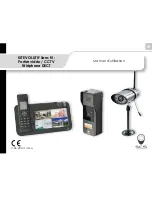
PAGE 8
User Manual PS 279 / August 2016 © ASL Intercom BV
9.0
PARTY LINE, TECHNICAL CONCEPT
User stations in an ASL intercom system are
connected via one or several 'party lines'. A party line
offers two way (‘full duplex’) communication and
consists of standard microphone (multi-pair) cable.
One wire is used as an audio line, one as a power line
and the screen of the cable functions as earth/return.
Current drive is used for signal transfer. Each station
utilizes a current amplifier to amplify the microphone
signal and place it on the common audio line where,
due to the constant line impedance (situated in the
power supply between XLR pin 3 and 1), a signal
voltage is developed which can be further amplified
and sent to the headphones or loudspeakers.
This principle has three advantages:
the use of a single audio line allows several
stations to talk and listen simultaneously
due to the high bridging impedance offered by
each station, the number of stations on the
party line has no influence on the level of the
communications signal
power and audio to the intercom stations use
the same cable
The Call signal is also sent as a current on the audio
line. It develops a DC potential over the line
impedance which will be sensed by each station and
interpreted as a Call signal.
10.0
CABLING
The intercom lines (the ‘party lines’) are of the shielded two-conductor microphone cable type. The intercom line
connectors are of the XLR-3 type. Audio and Call signals are on XLR pin 3, DC power is on XLR pin 2.
XLR pin 1 is connected to the shield of the cable which functions as the common return for audio and power.
T
he audio signal is transferred in an unbalanced way (see ‘Party Line, Technical Concept’).
To avoid earth loops (hum), the possible effect of electromagnetic fields and to minimize power loss, certain rules
have to be obeyed when installing the cabling of an intercom system :
Use high quality cable
Use high quality microphone cable (shielded two
conductor cable, minimum 2x 0.30 mm2).
In case multi-pair microphone cable is used, it should
be of high quality and each pair should consist of two
conductors (minimum 2x 0.15 mm2) with separate
shield and an overall shield.
Use flexible cable
Use flexible single and multi-pair microphone cable
instead of cable with solid cores, especially when the
cable is subjected to bending during operation or
installation.
Cable screens to XLR pin 1
The screen of each separate microphone cable and/or
the screen of each single pair in a multi-pair cable,
should be connected to pin 1 of each XLR-3
connector. Do not connect these screens to the metal
housing of ASL unitst or XLR-3 wall boxes.
See section ‘Earthing Concept’.
Connect metal cable trunks, wall boxes and overall
multi-pair cable screens to clean earth
Metal cable trunks, metal wall boxes and overall multi-
pair cable screens should be interconnected and, at
the 'central earth point' in the intercom network only,
be connected to a clean earth or a safety earth.
S
ee section ‘Earthing Concept’.
Keep metal connection boxes and cable trunks or
pipes isolated from other metal parts
Metal trunks or pipes for intercom cables and metal
connection boxes should be mounted in such a way
that they are isolated from any other metal housing or
construction part.
Keep cables parallel as much as possible
When two (multi channel) units in a network are
connected by more than one cable, make sure that
these cables are parallel to each other over the whole
distance between those units. When using multi-pair
cable, parallelism is ensured in the best possible way.
Avoid closed loops
Always avoid that intercom cables are making a closed
loop. So-called 'ring intercom' should not physically be
cabled as a ring..
Keep cables away from electromagnetic sources
Keep intercom cables away from high energy cables,
e.g. 115/230/400V mains power or dimmer controlled
feeds for spotlights. Intercom cables should cross high
energy cables at an angle of 90º only. Intercom cables
should never be in the same trunks as energy cables.
Place power supply in a central position
In case of a system powered by a separate power
supply: In order to diminish power losses, place the
power supply as close as possible to where most
power consumption occurs, in other words most user
stations are placed.
ASL powered units to a 'clean' mains outlet
Master stations or power supplies should be
connected to a mains outlet with a clean earth. Other
audio equipment may be connected to this mains
outlet, but avoid using an outlet which also powers
dimmer controlled lighting systems.




























